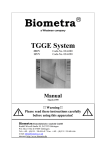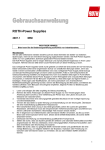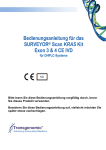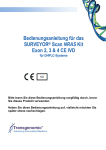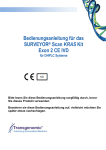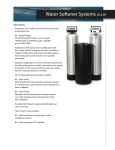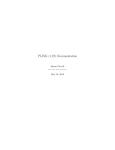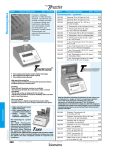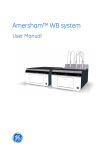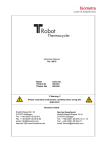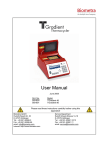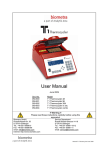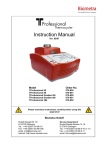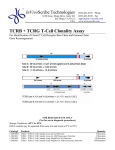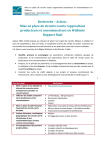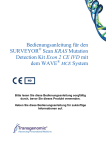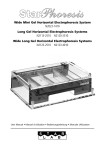Download TGGE System
Transcript
TGGE System Instruction Manual Ver. 09/10 Model Order No. TGGE System TGGE System (international) 024-000 024-090 Please read these instructions carefully before using this apparatus! Biometra GmbH Rudolf-Wissell-Str. 30 D-37079 Göttingen Tel.: ++49 (0)551-50 68 6-0 Fax: ++49 (0)551-50 68 6-66 email: [email protected] Internet: http://www.biometra.com Service Department Rudolf-Wissell-Strasse 14-16 D-37079 Göttingen Tel.: ++49 (0)551-50 68 6-10 or -12 Fax: ++49 (0)551-50 68 6-11 email: [email protected] This document describes the state at the time of publishing. It needs not necessarily agree with future versions. Subject to change! TGGE Manual October 2009 2 Contents 1. Introduction.....................................................................................................................6 1.1 Principle of the method .............................................................................................6 1.2 Field of Applications .................................................................................................6 1.3 Special features ........................................................................................................7 1.3.1 Peltier powered linear temperature gradient.....................................................7 1.3.2 Sensitivity..........................................................................................................8 1.3.3 Patented technology .........................................................................................8 1.4 Technical specifications............................................................................................9 1.5 Legal Notes ............................................................................................................10 1.5.1 Copyright ........................................................................................................10 1.5.2 Liability............................................................................................................10 1.5.3 Meaning of the Instructions.............................................................................10 2. Safety and Warning Notices ........................................................................................11 2.1 2.2 3. Installation.....................................................................................................................13 3.1 3.2 3.3 3.4 3.5 3.6 4. Definition of Symbols ..............................................................................................11 Safety instructions / general remarks .....................................................................11 Content of delivery..................................................................................................13 System Overview....................................................................................................13 Unpack and Check .................................................................................................14 Installation Conditions ............................................................................................14 Operation Voltage...................................................................................................15 Setup ......................................................................................................................15 Considerations for successful TGGE experiments...................................................16 4.1 Design of TGGE experiments.................................................................................17 4.2 Design of DNA fragment for TGGE ........................................................................17 4.2.1 Poland analysis...............................................................................................17 4.2.2 GC clamps ......................................................................................................21 4.2.3 Chemical clamp with Psoralen (Furo[3,2-g]coumarin, C11H6O3) ....................21 4.2.4 Use of SSCP primers......................................................................................22 4.3 Find correct temperature gradient ..........................................................................22 4.4 Parallel analysis of multiple samples ......................................................................23 5. Sample preparation ......................................................................................................24 5.1 5.2 5.3 6. Purity of samples ....................................................................................................24 Sample preparation for direct DNA analysis...........................................................24 Denaturation / Renaturation for heteroduplex analysis of DNA ..............................24 Operating.......................................................................................................................25 6.1 Casting of gels ........................................................................................................25 6.1.1 Assembly of the gel cuvette............................................................................25 6.1.2 Preparing gel solution .....................................................................................28 6.2 Pouring gels............................................................................................................29 TGGE Manual October 2009 3 6.3 Electrophoresis with the TGGE System .................................................................29 6.3.1 Electrophoresis conditions..............................................................................30 6.3.2 Conditions for mutation analysis.....................................................................30 6.3.3 Conditions for diversity analysis of bacterial populations (genetic fingerprint)31 6.3.4 Setup electrophoresis unit ..............................................................................31 6.3.5 Prior to assembly of the electrophoresis unit..................................................32 6.3.6 Gel setup for electrophoresis..........................................................................32 6.3.7 Perpendicular TGGE ......................................................................................33 6.3.8 Parallel TGGE.................................................................................................34 6.3.9 Identify optimum temperature gradient ...........................................................34 6.3.10 Calculate temperatures at different lanes .......................................................35 6.4 Programming the TGGE Controller ........................................................................37 6.4.1 Software main menu.......................................................................................37 6.4.2 Create / edit program......................................................................................37 6.4.3 Select program ...............................................................................................37 6.4.4 Name program................................................................................................37 6.4.5 Enter temperatures for the gradient block ......................................................38 6.4.6 Enter electrophoresis parameters...................................................................38 6.4.7 Start electrophoresis.......................................................................................39 6.4.8 Stop/pause electrophoresis ............................................................................40 6.4.9 View temperatures of the gradient..................................................................40 6.5 Special functions ....................................................................................................41 6.5.1 Print programs ................................................................................................41 6.5.2 Select / de-select signal..................................................................................41 6.5.3 Select language ..............................................................................................41 7. Staining TGGE Gels .....................................................................................................42 7.1 7.2 7.3 7.4 8. Silver staining protocol ...........................................................................................42 Ethidium bromide-staining ......................................................................................43 Autoradiography .....................................................................................................43 Elution of DNA from the TGGE gel .........................................................................43 Trouble shooting guide................................................................................................44 8.1 Error messages ......................................................................................................45 8.2 Optimization of parallel TGGE ................................................................................46 8.3 Optimization of TGGE for genetic fingerprinting of microorganisms.......................46 8.4 Optimisation of Heteroduplex analysis ...................................................................47 8.5 Evaluation of a heteroduplex analysis ....................................................................48 8.6 TGGE Testkit (024-050) .........................................................................................49 8.6.1 Perpendicular TGGE using the Biometra TGGE test kit .................................49 8.6.2 Parallel TGGE using the Biometra TGGE Test kit ..........................................50 8.6.3 Gel pictures TGGE Test kit.............................................................................50 9. Maintenance and repair ...............................................................................................51 9.1 9.2 9.3 10. 10.1 Cleaning and Maintenance .....................................................................................51 Servicing and repair................................................................................................51 Replacement of Spare Parts ..................................................................................51 Accessories ..............................................................................................................52 Consumables and spare parts................................................................................52 TGGE Manual October 2009 4 11. 11.1 Service.......................................................................................................................53 Instructions for return shipment ..............................................................................53 12. Equipment Decontamination Certificate ................................................................54 13. Note for the disposal of electric / electronic waste...............................................56 14. EU – Konformitätserklärung, EU - Declaration of Conformity..............................57 15. Warranty ....................................................................................................................58 16. Appendix ...................................................................................................................59 16.1 References .............................................................................................................59 16.2 Buffers ....................................................................................................................62 16.2.1 Running buffers: .............................................................................................62 16.2.2 Loading buffers: ..............................................................................................62 16.3 Other buffers:..........................................................................................................63 17. Subject Index ............................................................................................................64 TGGE Manual October 2009 5 1. Introduction Temperature Gradient Gel Electrophoresis is a powerful technique for the separation of nucleic acids or proteins. The TGGE method, which is covered by patents, uses the temperature dependent changes of conformation for separating molecules. Since the introduction of the first commercial available TGGE apparatus in 1989, temperature gradient gel electrophoresis has gained high interest in scientific and clinical research laboratories due to the unprecedented resolution capability and easiness of analysis. The range of scientific publications using the TGGE method is broad and covers all disciplines which use molecular biology methods: e.g. oncology, virology, immunology, RNA viroid research, prion research, population analysis. The TGGE method has also been used for quantitative analysis in industry and for conformational analysis of proteins. 1.1 Principle of the method Conventional protein or nucleic acid electrophoresis separates molecules according to their size or charge. TGGE adds a new parameter for separation, namely the melting behaviour of a molecule. The melting behaviour is determined by primary sequence and secondary and tertiary structure of the molecule and can be changed by external influences like temperature, salt concentration, pH etc. During electrophoresis the sample migrates along a temperature gradient. As the temperature rises the molecules start to denature. Working with PCR fragments for example electrophoresis starts with double stranded molecules. At a certain temperature the DNA starts to melt, resulting in a fork-like structure (partial single strand, see Figure 1). In this conformation the migration is slowed down compared to a completely double stranded DNA fragment (of same size). Since the melting temperature strongly depends on the base sequence, DNA fragments of same size but different sequence can be separated. This is used in mutation detection where PCR fragments of identical size but different sequence are separated. Thus TGGE not only separates molecules but gives additional information about melting behaviour and stability. electrophoresis cold ds DNA partial ss ss DNA warm Figure 1: Different conformations of DNA during temperature gradient gel electrophoresis. 1.2 Field of Applications The Biometra TGGE system separates molecules in a temperature gradient. Unlike chemical gradients the peltier driven temperature gradient is controlled by a microprocessor and thus is providing unmatched reproducibility. The most common application for TGGE is mutation analysis of PCR fragments. The DNA molecules become separated in the temperature TGGE Manual October 2009 6 gradient their melting behavior. With TGGE PCR fragments that only have single base substitutions can be resolved. But, the TGGE system is not restricted to the analysis of DNA fragments only. It can be used for versatile applications like: • Mutation analysis • Heteroduplex analysis • DNA methylation studies (Imprinting) • Differentiation of amplicon and competitor for quantitative DNA analyses • Fidelity assay for thermostable polymerases • Secondary structure analysis of RNA • Analysis of dsRNA molecules • Thermal stability analysis of proteins • Protein/protein or protein/ligand interaction analysis 1.3 Special features 1.3.1 Peltier powered linear temperature gradient The heart of the TGGE system is the temperature block which is powered by peltier technology. Thanks to precise microprocessor control a linear temperature gradient is generated providing maximum reproducibility. Thus assay conditions can be much better controlled compared to conventional chemical gradients (DGGE) or temporal gradients using water baths. The Biometra TGGE system is available in two formats. The standard TGGE “mini” system operates small gels and is therefore ideally suited for fast, serial experiments. The TGGE MAXI system provides a large separation distance and allows high parallel sample throughput. Using the Biometra TGGE system it is very easy to separate samples either parallel or perpendicular to a temperature gradient. All that has to be changed is the position of the buffer tanks. Whereas perpendicular TGGE is mainly used for the optimization of separation conditions, parallel TGGE allows fast analysis of multiple samples. perpendicular TGGE Temperature gradient is perpendicular to the electrophoretic migration: One sample is separated over a broad temperature range to determine the optimum temperature gradient or to analyze temperature dependent changes in conformation Parallel TGGE Temperature gradient is parallel to electrophoretic migration: multiple samples are separated in parallel TGGE Manual October 2009 7 Figure 2: Typical results after perpendicular TGGE (A: temperature gradient from left to right) and parallel TGGE (B: temperature gradient from top to bottom). 1.3.2 Sensitivity Because of the small amount of material used for separation, DNA or RNA fragments appear as fine bands which can be clearly distinguished from each other. Even complex band patterns can be analyzed due to the high resolution capability of the gradient block. Comparing the TGGE method with other screening methods like SSCP the superior performance of the TGGE method becomes evident. In contrast to direct sequencing TGGE also detects mutations in mixed DNA samples. Whenever heterozygous DNA is to be analyzed, direct sequencing will not give a clear signal at the position of the mutation. This is especially the case if the mutated gene is masked by a high background of normal cells. TGGE reliably detects mutations in a 1:10 dilution (and higher) of wildtype DNA. 1.3.3 Patented technology TGGE is protected by patents in most countries of the world. The patent for the TGGE method is held by Qiagen AG, Hilden. Biometra is the exclusive licensee for manufacturing and distribution of TGGE instrumentation. TGGE Manual October 2009 8 1.4 Technical specifications TGGE System Electrophoresis unit Temperature gradient formation Block size Temperature range Linear temperature gradient Temperature accuracy Temperature uniformity Glass plates Gel size Max. separation distance Electrophoresis unit with temperature gradient block and two removable buffer chambers, power supply, starter kit. High performance Peltier technology 9 x 9 cm 5 – 80 °C maximum 45 °C + 0.3 °C + 0.5 °C 9 x 9 cm approx. 7,8 x 4,2 cm Perpendicular 4 cm Parallel 5 cm Sample number (volume) 10 (5µl) 12 (3µl) 18 (1,5µl) Dimensions (DxWxH) 23 x 23 x 23 cm Weight 4,2 kg Display Interfaces Voltage Microprocessor driven control of temperature gradient and electrophoretic parameters 31 x 22 x 12 cm 3,8 kg up to 100 programs can be stored constant Voltage V/h integration Programs can contain different steps (pre-run, pause, run) LCD display, 4 lines, English / German parallel (Centronics), serial (RS 232) 110 / 230 V Power pack Voltage Current Wattage Control Dimensions (DxWxH) Weight Integrated maximum 400 V maximum 500 mA maximum 30 W Constant Voltage - TGGE System Controller Dimensions (DxWxH) Weight Program stores Program modes TGGE Manual October 2009 9 1.5 Legal Notes 1.5.1 Copyright All rights reserved. It is not allowed to copy and publish the manual or parts of it in any form as copies, micro film or other methods without a written authorisation from Biometra. Biometra is pointing out that applied company and brand names are usually protected trade marks. The TGGE method is covered by patents issued to Diagen (now QIAGEN GmbH). The polymerase chain reaction (PCR) process is covered by patents issued to Hoffman-La Roche. Acryl-GlideTM is a trademark of Amresco Inc. Biometra is a trademark of Biometra GmbH. The POLAND software service established by Gerhard Steger, Department of Biophysics, University of Duesseldorf, is available by internet: www.biophys.uni-duesseldorf.de/POLAND/poland.html 1.5.2 Liability Biometra is not liable for damages and injuries caused by use not considering these operating instructions in parts or completely. 1.5.3 Meaning of the Instructions Biometra recommends that you first read these instructions carefully. This operation instruction is part of the product and should be kept over the full life-time of the instrument. It should also be forwarded to subsequent owners and users. Make sure that additions and updates are inserted into the operation instructions. TGGE Manual October 2009 10 2. Safety and Warning Notices 2.1 Definition of Symbols Symbol Definition Caution! Refer to instruction manual! Danger! High voltage! Fragile! Danger! Hot surface! 2.2 Safety instructions / general remarks The thermoblock will reach high temperatures during operation. The thermoblock can burn you. The TGGE system contains no user serviceable parts. Do not open the housing instrument. Service and repair may only be carried out by the Biometra Service department or otherwise qualified technical personal. Do not use the instrument when damages of the housing, block, cable or other parts are visible. Prior to connecting the unit to the power source please ensure that the voltage setting at the fuse holder at backside of the power supply is set to the required voltage. Unplug the power cable before you open the TGGE system. Danger of electric shock! The thermoblock is covered with Teflon film. Avoid damaging this film. Make sure that the appliance connector and the plug of the supply cord are accessible, so you can separate the instrument from the mains. Connect the TGGE system to a grounded socket. Appropriate safety regulations must be observed when working with infectious, pathogenic or radioactive material. Ask the responsible local safety inspector for details. TGGE Manual October 2009 11 Place the TGGE system on a stable, non flammable surface in a dry, safe environment. Ensure that both the ventilation slits of the TGGE block not clogged by dust or other material. Danger of overheating! Do not fill buffer chambers above marking for maximum level Do not move instrument during operation In case of strong condensation under the safety lid stop run, dry instrument and re-start If buffer has been spilled on the electrophoresis unit, clean it carefully before start of electrophoresis Do not use paraffin oil or kerosene on the thermoblock. Switch off power before removing the safety lid This instrument is designed and certified to meet EN 61010-1 safety standards. It should not be modified or altered in any way. Alteration of this instrument will void the warranty, void the EN61010-1 certification, and create a potential safety hazard. Do not use alcohol (e.g. methanol, ethanol), organic solvents or abrasives to clean the instrument. TGGE Manual October 2009 12 3. Installation 3.1 Content of delivery 1) Electrophoresis unit including thermoblock, buffer chambers, safety lid 2) Controller incl. power supply control of electrophoresis parameters (Voltage) and temperature gradient 3) Starter Kit Glass plates, sealings, cover films, polybond films, buffer wicks, binder clips, sample Acryl GlideTM* (*only in Germany) 4) Manual Please keep the original packaging material for return shipment in case of servicing. TGGE System, 230/115 V electrophoresis unit with high precision gradient block, 2 buffer chambers for variable positioning, controller with integrated power supply, manual, starter kit 024-003 024-000 TGGE System, 230/115 V electrophoresis unit with high precision gradient block, 2 buffer chambers for variable positioning, controller with integrated power supply, manual, starter kit 024-093 024-090 3.2 System Overview The TGGE System contains all components necessary to get started. All kinds of TGGE applications (parallel or perpendicular TGGE, Constant Temperature GE, Time resolved TGGE) can be run with the Biometra TGGE System. A broad range of different glass plates are available and can be ordered from Biometra or your local distributor (see section 10). TGGE Manual October 2009 13 Safety lid Buffer c hambers Elec trophoresis unit c ontroller c ord plug Figure 3: TGGE Electrophoresis unit 3.3 Unpack and Check Unpack and carefully examine the instrument. Report any damage to Biometra. Do not attempt to operate this device if physical damage is present. Please keep the original packing material for return shipment in case of service issues !! Attention !! Please fill out and send back the warranty registration card. This is important for you to claim full warranty. 3.4 Installation Conditions • Place the TGGE system on a stable surface in a dry, safe environment. • Let equilibrate the TGGE system to room temperature before starting operation. • Make sure that the appliance connector and the plug of the supply cord are accessible, so you can separate the instrument from the mains. • Connect the TGGE system to a grounded socket. TGGE Manual October 2009 14 Ensure that the ventilation slits at the electrophoresis unit are unobstructed. Insufficient ventilation can cause overheating of the instrument. Prior to connecting the unit to the power source please ensure that the voltage selector at the back side of the power supply is set to the required voltage. Danger of electric shock! Unplug the power cable before you open the TGGE system. 3.5 Operation Voltage Important: Prior to connecting the TGGE system to the mains, make sure that the voltage setting of the power supply is in accordance with your mains voltage. The set operating voltage is displayed in the small window of the fuse holder at the backside of the power supply. The TGGE system can operate at 110 or 230 Volt. To change operation voltage of the TGGE system, switch off the instrument and disconnect the mains plug. Press the two clips both ends of the fuse holder and excerpt it. Pull out the cream coloured insert from the fuse holder and turn it by 180°. Insert it again and control the voltage displayed in the small window of the fuse holder. If the setting is correct insert the fuse holder to the power supply again. Figure 4: TGGE system fuse holder 3.6 Setup 1) Connect electrophoresis unit and controller. 2) Connect power cables from the safety lid to the controller The buffer chambers can be placed in two orientations, depending on the direction of the temperature gradient. Be sure that the orientation is correct. The markings on the gradient block (L0 to L6) indicate the direction of the temperature gradient. The direction of electrophoresis (minus to plus for nucleic acids) is indicated on the safety lid. TGGE Manual October 2009 15 4. Considerations for successful TGGE experiments TGGE is a powerful technique to separate molecules of same size, but different sequence. Nevertheless, every DNA fragment has its own characteristics and three steps have to be taken before successful analysis of multiple samples in parallel TGGE can begin. Each of the following steps is described in detail in this section. Step 1 Check the sequence of your PCR fragment in Poland analysis. The Poland computer program (http://www.biophys.uni-duesseldorf.de/POLAND/poland.html) calculates the melting behavior of dsDNA molecules. Poland analysis can predict, whether a fragment is suited for TGGE or not. Analysis is available online and free of charge (see section 1.5.1). Melting profile is ok Poland analysis shows a satisfying profile. Proceed with step 2 Melting profile is not ok If Poland analysis shows that the fragment in its current state is not suited for TGGE, optimize your primer design. Never try to separate samples in TGGE if the calculated melting profile is not ok. Back to step 1 Step 2 If the Poland analysis shows a suitable melting profile you should test separation conditions in a perpendicular TGGE. In perpendicular TGGE, a large aliquot of the sample runs over a broad temperature range. The result of parallel TGGE allows identification of the temperature gradient for parallel analysis. Perpendicular gel is ok Perpendicular TGGE shows a nice melting curve. Proceed with step 3 Perpendicular gel is not ok If perpendicular analysis does not show the expected melting profile, check sequence again in Poland analysis. Also check purity of chemicals and electrophoretic conditions. Do not try samples is parallel TGGE, as long as the perpendicular gel does not show a defined melting curve. Back to step 2 Step 3 Set up a parallel gel with the temperature gradient derived from the perpendicular gel. Separation can be optimized by varying the temperature gradient and voltage. TGGE Manual October 2009 16 4.1 Design of TGGE experiments There are 3 steps in the setup of a new TGGE experiment: 1) Design of the PCR fragment 2) Identification of the correct temperature gradient 3) Parallel analysis of multiple samples 4.2 Design of DNA fragment for TGGE The design of the DNA fragment is an important step for successful TGGE. Starting with the gene fragment of interest PCR primers should be designed with a conventional computer program. The melting behavior of the resulting fragment should then be checked with the Poland software. It is essential that the DNA fragment shows different melting domains. If there is only one single melting domain, an artificial higher melting domain (called GC clamp) must be added during PCR. 4.2.1 Poland analysis The melting profile of a DNA fragment can be analyzed with a computer program. The Poland software calculates the melting behaviour of a DNA fragment according to its base sequence. This software is free accessible via the internet. (http://www.biophys.uni-duesseldorf.de/POLAND/poland.html). How to perform a Poland analysis • Open start page (URL see above) • 1) enter a name for the query • 2) copy / paste DNA sequence in the sequence window • 3) choose the Tm plot (de-activate all other plots) • 4) submit query • 5) retrieve Tm plot (melting curve) TGGE Manual October 2009 17 Poland service request form The Poland server will calculate the thermal denaturation profile of double-stranded RNA, DNA or RNA/DNA-hybrids based on sequence input and parameter settings in this form. NEW: Thermodynamic parameters set for dsDNA in 75 mM NaCl (Blake & Delcourt) added. Calculation is based on Poland's algorithm in the implementation described by Steger. Graphics results are directly sent to your WWW client. 1) Sequence title line: TGGE Manual October 2009 18 2) Sequence: (plain format; no numbers; max. 1000 nts; min. 5 nts) Mismatched positions: (comma-separated numbers) Thermodynamic parameters: Dissociation constant ß: TGGE Manual October 2009 Oligonucleotide (ß is function of seq.length) Long double strand (default: ß=1.0E-3/M) 19 Strand concentration: (default: 1.0E-6 M) High temperature Temperature Low temperature limit: limit: (default: 110.0 step size: (default: 40.0 °C) °C) (default: 2.0 °C) Temperature range: 3) Tm(p=50%) plot 3d plot Mobility plot Which graphics do you want: Melting curve Diff. melting curve Graphics size: (GIF format) 4) submit Click here to , or Zurücksetzen Click here to the form to defaults. The Tm plot (second order, red color) shows the melting profile of the DNA fragment according to the base sequence. The ideal fragment shows at least two distinct melting domains. Note that mutations can be detected in all but the highest melting domain. This means that in a DNA fragment with two melting domains, mutations can only be detected in the lower melting domain. Figure 5: Tm plot of a 140bp DNA fragment resulting from Poland analysis. The second order curve (red color in the original) shows two different melting domains. If the fragment consists of a single melting domain only, or if you want to scan the entire fragment for mutations, add a so called GC clamp to one end of the PCR fragment. TGGE Manual October 2009 20 4.2.2 GC clamps A GC clamp is an artificial, high melting domain which is attached to one end of the fragment during PCR. The name “GC clamp” implies that this short stretch will hold the DNA fragment together, preventing a dissociation into the single strands at higher temperatures. The optimum location for the GC clamp at the PCR fragment (5´ or 3´) can be easily checked with the Poland software. Copy / paste the GC sequence to either side of your sequence and repeat Poland analysis. In the following box you will find different examples for a GC clamp. short GC-clamp (23 bp): cccgc cgcgc cccgc cgccc gcc long GC-clamp (40 bp)44: cgccc gccgc gcccc gcgcc cggcc cgccg ccccc gcccg long GC-camp (39 bp)45: ccccg ccccc gccgc ccccc ccgcg cccgg cgccc ccgc To integrate a GC clamp into a PCR fragment, one of the two primers has to be modified. The non-specific GC sequence is added to the 5´-end of the primer. Thus the GC sequence is incorporated in the fragment during PCR. Prior to order primers check the melting behaviour of the PCR fragment with GC clamp by Poland analysis (see chapter 4.2.1). Figure 6 shows a Tm plot for a PCR fragment with GC clamp either at the 5’-or 3’-end. GC-clamp at 5´end GC-clamp at 3´end bubble Figure 6: Tm-Plot of a PCR fragment with GC clamp at the 5’-end or at the 3’-end. Whereas the fragment with 5’GC clamp has domains that melt consecutively and is well suited for TGGE analysis the fragment with 3’-GC clamp has a domain in the middle that melts at lower temperature compared to the neighbouring domains and is therefore leading to bubble formation. Thus the 3’-GC clamp for this fragment will not work for TGGE analysis. 4.2.3 Chemical clamp with Psoralen (Furo[3,2-g]coumarin, C11H6O3) In addition to “clamping” a fragment with an artificial high melting domain it is as well possible to covalently fix the end of a PCR fragment. To achieve this, one of the primers carries a Psoralen molecule. Psoralen is a high reactive group when exposed to UV radiation. Thus it is possible to covalently close one end of the PCR fragment. The optimal primer sequence may be 5’(Pso)pTaPpnpnp.....3’, given the preference of Psoralen for binding between TpA and ApT pairs 13,46,47. Crosslinking of the PCR product is done e.g. in a flat-bottom microtiter plate using a 365 nm UV source. Working with small volumes it may be necessary to minimize evaporation by cross-linking at 4 – 10°C. The yield is not affected by TGGE Manual October 2009 21 temperature. The distance of the sample from the UV source affects the yield. 15 min at 0.5 cm distance of the sample from an 8 W UV lamp is sufficient. 4.2.4 Use of SSCP primers In many cases primer from SSCP may be used for TGGE analysis. Nevertheless, the resulting DNA fragments should be checked in the Poland analysis. If there is only one melting domain add a GC clamp to one of the primers (see section 4.2.2) 4.3 Find correct temperature gradient Poland analysis gives the first indication, which temperature gradient should be applied for parallel analysis of multiple samples. Under experimental conditions separation is performed in the presence of high concentrations of urea. Urea lowers the melting temperature of the DNA. This is important because gel electrophoresis at very high temperatures may lead to partial drying of the gel, resulting in a disturbed separation pattern. Therefore it is necessary to identify the optimum temperature gradient under experimental conditions. To identify the optimum temperature gradient the DNA fragment is separated in a perpendicular TGGE. This means the temperature gradient is perpendicular to the migration of samples (see section 6.3.7). Thus the migration of a fragment can be checked simultaneously at different temperatures in a single run. If the PCR fragment has been designed properly the separation in a perpendicular temperature gradient leads to a distinct melting curve (see Figure 7) Figure 7: Identification of the optimum temperature gradient in a perpendicular TGGE. At low temperature (below T1) DNA migrates as a double strand (left side). At intermediate temperature (between T1 and T2) the DNA opens at one side, the partial double strand is increasingly slowed down. Above T2 the DNA separates into the single strands. At T1 the double strand starts to melt and forms a branched structure. At T2 the partial double strand separates irreversibly into the single strands. Analysis of samples in parallel TGGE should be performed precisely in this temperature range between T1 and T2. How to identify the optimum temperature range from a perpendicular gel: Place the stained gel on the plastic film with the printed lines (l0 to L6). Identify the line where the double strand starts to melt (T1) and the line where the double strands separates into the single strands (T2). For the calculation of temperature at the corresponding lines see section 6.3.10. TGGE Manual October 2009 22 4.4 Parallel analysis of multiple samples electrophoresis After identification of T1 and T2 in a perpendicular TGGE this temperature gradient is spread over the whole block for parallel analysis. cold warm T1 T2 Figure 8: Application of T1 and T2 in a parallel gel. Note: The DNA fragments are separated by their melting behavior. They can be distinguished as soon as the fragments begin to melt, i.e. they form a fork like structure (temperature higher than T1). During electrophoresis the fragments should not separate into single strands. This is an irreversible transition resulting in diffuse bands. Note: If there are only small differences in the migration of different samples, perform a heteroduplex analysis (see chapter 8.4) TGGE Manual October 2009 23 5. Sample preparation 5.1 Purity of samples Due to the high sensitivity of the staining procedure after TGGE it is recommended to use purified DNA, RNA or protein samples. Any impurities might be misinterpreted after TGGE, thereby making the analysis of gels difficult. Nevertheless it is possible to use even crude mixtures for TGGE analysis. PCR-amplified DNA fragments usually can be analyzed without further purification. Please note that the presence of high amounts of nonspecific, secondary PCR products may result in difficulties with interpretation of band pattern, melting profile, etc. For example, in parallel TGGE, nonspecific bands with a higher molecular weight than the specific PCR product may be misinterpreted as heteroduplices, or analogs with lower thermal stabilities. Therefore, prior to TGGE check the PCR product in a conventional agarose gel. If necessary, purify your specific PCR product, e.g., by agarose gel electrophoresis and subsequent gel extraction. 5.2 Sample preparation for direct DNA analysis 1 volume of DNA/RNA samples is mixed with 1 volume of TBE or Na-TAE loading buffer or with 0.1 volume of the total loading volume ME loading buffer (see Appendix). The resulting mixture is loaded directly on to the polyacrylamid gels. Be sure that the slots are filled up to maximum (if necessary, add 1x loading buffer to fill up the slots to maximum). In case of low-concentration samples we recommend to prepare 5x conc. loading buffer. 0.2 volume of this concentrated loading buffer is mixed with 0.8 volumes of the sample and loaded onto the gel. 5.3 Denaturation / Renaturation for heteroduplex analysis of DNA Mix sample with equal amount of standard DNA and heat to 95°C for 5 minutes (denaturation). Then let slowly cool down to 50°C (renaturation). This can be done by programming a thermocycler to 94°C for 5 minutes and then 50 °C for 15 minutes with a ramping rate of –0.1°C/second. The sample is then loaded directly to the gel. In order to achieve the recommended loading volumes for diagonal or perpendicular TGGE, the sample volume should be adjusted with running buffer. Important: Do not denature/renature DNA for community profiling (see chapter 6.3.3)! TGGE Manual October 2009 24 6. Operating 6.1 Casting of gels 6.1.1 Assembly of the gel cuvette The TGGE system (024-000) contains all components needed for casting custom gels (glass plates, clamps etc.). There are two different types of gels for TGGE. For perpendicular gels one long slot is used to separate one sample over a broad temperature range (use glass plate with slot former, 024-023). For parallel gels samples are applied to single slots (use glass plate with slot formers, 024-022 or 024-025). The gel cuvette consists of one glass plate with spacers and slot formers (024-022 or 024-025) and a glass plate without spacers (024-021). The sandwich is fixed with 3 plastic clamps. The thinness of the polyacrylamide gel makes it necessary to cast the gel on a gel support film (Polybond film, order number: 024-030). The gel will stay on this film throughout the whole procedure (including silver stain). A. Cover glass plate without spacers (bonding plate) B. Polybond film C. Glass plate with slot formers and spacers (different types of slots available). Bonding plate (024-021) Glass plate with slot fomer and spacers (024-022) Poybond support film (024-030) Figure 9: Components of the TGGE cuvette for casting gels Note: The gel is poured on Polybond film to optimize temperature transition between block and gel. The gel is bound covalently to this hydrophilic Polybond film (024-030). Note: The gel sticks to the Polybond film throughout the whole procedure, including staining. 1) Glass plates must be dry and free of any dirt or dust. Please wear powder-free gloves during cleaning and assembly of gel sandwich, to prevent contamination (which will interfere with silver staining). Clean both glass plates with 70% ethanol and a soft tissue. TGGE Manual October 2009 25 Do not use strong acidic or basic solutions or organic solvents for cleaning the glass plates. Do not apply mechanical stress on slot formers (i.e. brushing or rubbing) Do not incubate glass plates over night in cleaning solutions! 2) The glass plate with spacer and slot former must be carefully treated with a repelling agent. This is essential for easy removal of the polymerized gel from the glass plate with slot formers. Apply approx. 0.5 ml of gel repellent solution (Acryl Glide, Amresco or Repel silane, Sigma) on the glass plate WITH SPACERS and spread it carefully especially between the slot former. Wait 5 min, than polish the plate with soft tissue to remove residual solution! Do not drop repelling solution on the spacers of the glass plate! This will lead to leakage of the gel cuvette during polymerization. Do not treat the bonding plate with repelling agent. 3) Clean spacers with ethanol before assembling the glass plate sandwich. 4) Apply some silicone grease onto the spacers (to prevent leakage). Note: Treatment of the glass plate with slot formers should be repeated prior to every use. 5) Use original pre-cut Polybond support film which perfectly fits onto the gradient block. Remove protecting paper sheet from polybond film prior to assembly of sandwich. Handle Polybond film only with powder-free gloves. Attach Polybond film firmly to the bonding glass plate by gently rubbing with a soft tissue. To improve contact between glass plate and film a drop of water may be applied behind the Polybond film. Note: The Polybond support film has a hydrophilic coating. The gel matrix binds covalently to the support film. In earlier batches, Polybond film was coated only on one side. Today, both sides can be used for gel casting, the orientation of the film is not important. Note: The support film may be fixed along the upper side of the cover glass plate with ordinary adhesive tape. This way no gel solution can accidentally get behind the support film. TGGE Manual October 2009 26 Bonding plate (024-021) Poybond support film (024-030) Glass plate with slot fomer and spacers (024-022) Figure 10: Assembly of the TGGE cuvette for casting gels 6) Assemble gel sandwich and fix it with the 3 plastic clamps. Note: the clamps should be placed directly on the spacers. 7) Set gel sandwich upright to pour the gel. Clamp Clamp Clamp Figure 11: Final setup of the gel sandwich Figure 12: Gel casting stand Note: For convenient casting of 5 gels in parallel we recommend gel casting stand 024-028, (Figure 12). TGGE Manual October 2009 27 6.1.2 Preparing gel solution The choice of the buffer system has a strong impact on TGGE analysis. Concentration of salt and denaturing agents (urea or formatted) strongly affects the melting temperature of DNA and proteins. In general, urea is used for the separation of nucleic acids in a concentration between 7 and 8M. Urea reduces the melting temperature and thus enables a separation at lower temperatures (which is favorable, because at higher temperatures the gel tends to dry out). To further reduce the melting temperature (deionized) formamide may be used in concentrations of up to 20%. The most popular buffer systems for TGGE are TBE, TAE and MOPS. In the following, two standard protocols for TBE and MOPS buffer systems are listed. Please note, that the buffer system should be adapted to each special kind of application. Each gel sandwich contains approx. 2.5 ml polyacrylamide solution. We recommend to prepare 10 ml solution to pour 3-4 gels at a time. Gels should be used within 24 hours after polymerization. To prevent gel drying, wrap polymerized gels into saran foil or wet plastic bags. Wet paper towels may be used for short time storage (1 day). The below gel composition is intended for mutation analysis with the TGGE test Kit (024050). Gel protocols for other applications can be found in section 6.3. Polyacrylamide is a toxic substance. Skin contact or inhalation must be strictly avoided. Wearing laboratory gloves is mandatory during all steps. Please carefully read the safety sheets of the chemicals prior to use and behave accordingly. Protocol for 10 ml gel solution (3 gels) Volume / amount Final concentration Urea 4,8 g 8M 40% Acrylamide/Bis-Acrylamide (37,5 : 1) 2 ml 8% 10 x TAE 1 ml 1x 40% Glycerol 500 µl 2% Adjust with aqua bidest to 10 ml • Stir solution at < 50°C until urea is completely dissolved • Carefully degas gel solution • Let solution cool down to room temperature and start polymerization with APS (4%) 40 µl TEMED 9 µl • Once TEMED and APS have been added, the following steps must be performed without delay. • Load gel solution in a syringe and attach a 0,4µm or 0,25µm sterile filter TGGE Manual October 2009 28 • Pour gel through sterile filter into the glass sandwich. 6.2 Pouring gels Figure 13: Pouring polyacrylamide gel. • Hold gel sandwich at an angle of 45° when pouring. The solution should run slowly along one side of the plate sandwich to avoid air bubbles. Turn gel sandwich into vertical position. • Polymerization of gel for 1 - 1.5 h or over night at room temperature. The sandwich should stand up vertically and must not be moved during polymerization. Overlaying the gel solution with 2-Butanol will yield an even gel surface after polymerization. • After polymerization remove clamps. Remove the glass plate without spacers by sliding the glass plate away from the rest of the sandwich (if you have fixed the support film with adhesive tape, remove or cut tape first). The gel must stick on the support film. • Slowly take off the Polybond film with the adhering polyacrylamide gel from the other glass plate. In the area of the slot former remove the Polybond film very carefully to avoid any damage to the slots. • Do only use perfect shaped slots because otherwise the bands will be distorted. Note: After dissolution of urea batch solution may be stored up to 2 weeks at room temperature. Remove clamps and wrap gel sandwich including glass plates in wet paper towels. Store the sandwich in a tight plastic bag. Gels must not be stored at low temperatures (i.e. refrigerator) because this will lead to precipitation of urea. Note: Prepare electrophoresis unit prior to disassembling the gel cuvette. The gel should not be exposed to the air for extended periods since this may lead to drying of the gel. 6.3 Electrophoresis with the TGGE System Since in TGGE molecules are separated according to their primary sequence, there are many potential fields of application. For some applications TGGE has become already the TGGE Manual October 2009 29 method of choice. Currently, there are two major fields: Mutation analysis in PCR fragments and diversity analysis of complex bacterial samples. The main difference between these two applications is that in the former case only one or two PCR fragments (mutant and wildtype) are separated per lane, whereas in the latter case a mixture of many (up to 150) fragments are separated in one lane. While sample throughput is always an important aspect, long separation distance is mainly necessary, if many bands are to be separated. Therefore the TGGE maxi system is the system of choice for diversity analysis, whereas the TGGE standard system allows short electrophoresis times and provides high serial sample throughput for mutation analysis. 6.3.1 Electrophoresis conditions The electrophoresis unit of the TGGE System has been designed to accommodate TGGE and all related applications like CTGE, TTGE and SSCP without cumbersome changes. In contrast to conventional electrophoresis techniques like PAGE or agarose gel electrophoresis the migration behaviour of samples in TGGE depends very strongly on the temperature gradient. Better separation in TGGE is NOT achieved by longer electrophoresis times! Once the samples start to melt their migration is almost stopped. Therefore extended migration times and higher voltage will rather lead to fuzzy bands than to a better resolution. To improve resolution (i.e. distance between two bands in one lane) the temperature gradient has to bee adjusted (see section 8.1). In general migration of samples in TGGE depends on • Temperature gradient • Buffer system • Gel composition • Voltage • The kind of sample, e.g. protein, nucleic acid, fragment size • The kind of application, e.g. parallel or perpendicular TGGE • Sample preparation, e.g. high salt or low salt preparation Any recommendations should be regarded as guidelines to start with. Further improvement of the analysis should be done by adjusting the run conditions to individual needs. Important: The TGGE controller is designed to control voltage NOT amperage. [mA] and [Vh] should be set to maximum. 6.3.2 Conditions for mutation analysis Since each DNA fragment has its own melting characteristic, there can be no general valid parameters for mutation analysis. The following parameters have been optimized for separating the Biometra TGGE test kit DNA (024-050). If other fragments are to be analyzed, please optimize parameters as described in chapter 4 and 8. Gel composition: 1 x TAE buffer, 8% Polyacrylamide (37.5:1), 8M Urea, 2% Glycerol Temperature gradient: L1: 39°C, L6 54°C Electrophoresis: 250V, 50 min TGGE Manual October 2009 30 6.3.3 Conditions for diversity analysis of bacterial populations (genetic fingerprint) For genetic fingerprinting primers against 16SrRNA genes are used. Depending on the complexity of the sample and the primer design quite a high number of PCR fragments can arise from one sample. In this regard there are two major differences to mutation analysis: 1) the number of fragments per lane is much higher 2) the amount of DNA per band is lower. To separate all the many fragments a rather flat gradient is used which has to be optimized very carefully. For detecting low amounts of DNA a clear staining background is essential. The silver staining protocol (chapter .) has been optimized for gels with high content of urea and formamide and thus achieves high sensitivity at low background. For microbial diversity analysis we recommend the following conditions. However, these parameters can only be the starting point for individual optimization. Gel composition: 1 x TAE buffer, 6% Polyacrylamide (37.5:1), 8M Urea, 2% Glycerol, 20% Formamide Temperature gradient: L1: 33°C, L6 44°C Electrophoresis: 130V, 2h Important: Do not denature/renature the DNA fragments prior to electrophoresis! 6.3.4 Setup electrophoresis unit The Biometra TGGE system is a horizontal electrophoresis system. The buffer bridges to the gel are established by layering one side of each buffer wick (024-003) on the gel and submerging the other in the buffer inside the tank. To protect the gel from drying, it is covered with a gel cover film (024-032). The complete setup, consisting of gel with cover film and buffer wicks, is covered with the gel cover plate. The gel cover plate has two sealings and fits tightly onto the thermoblock. It holds the buffer wicks in place and helps to build a humidity chamber around the gel. This is important to prevent evaporation during the run. Important: Never run a gel without gel cover plate. (This could lead to massive condensation under the safety lid. Danger of electric shock.) Gel cover plate Sample Figure 14: Set up of the gel for electrophoresis TGGE Manual October 2009 31 6.3.5 Prior to assembly of the electrophoresis unit Note: Be sure to have everything on hand, to avoid extended handling times. Do not let the disassembled gel dry while setting up the electrophoresis system. Prepare: • parallel or perpendicular gel (see section 6.3.7 or section 6.3.8) • samples in loading buffer (for sample preparation see chapter 6.4) • 500 ml 1 x TAE running buffer (chapter 16.2.1) • 2 buffer wicks (024-003) • 1 cover film (024-035) • thermal coupling solution (0.01% Triton) • gel cover plate (024-031) 6.3.6 Gel setup for electrophoresis 1) Adjust electrophoresis chamber with the 4 levelling feet. 2) Fill 250 ml running buffer in each buffer tank (check orientation of the buffer tanks: parallel or perpendicular TGGE, see section 6.3.7 or section 6.3.8). Note: Wipe off any spilled buffer from the electrophoresis unit. Never run device if buffer has been spilled. 3) Soak 2 buffer wicks with running buffer 4) Disassemble gel sandwich. Clean backside of the gel support film with a soft tissue. 5) Apply 150µl of thermal coupling solution (0.01% Triton) on the thermoblock Note: The volume of coupling solution should be as small as possible. Excess coupling solution leads to an irreproducible temperature distribution under the gel. The result is a wavelike migration front and poor separation of fragments. 6) Place the gel on the thermoblock. The thermal coupling solution should spread over the whole block. Avoid bubbles. Wipe off any residual coupling solution along the edges of the gel support film. Note: The thermal coupling solution is essential for efficient heat transfer from block to gel. If bubbles are trapped under the gel support film, remove support film with gel from the block and place it back again on the block. 7) Cover the gel with a cover film. The cover film should be placed just beneath the slots. 8) Attach pre-soaked buffer wicks on top and bottom of the gel TGGE Manual October 2009 32 Cover film Buffer wick Gel Buffer wick Figure 15: Setup of gel, cover film and buffer wicks. 9) Load samples (approx. 5µl each for parallel gel with 8 slots, approx. 50µl for perpendicular gel with 1 slot) Note: Be careful not to touch the samples with the buffer wick! Otherwise the samples will quickly diffuse into the wick. 10) Attach gel cover plate (the cover plate should have contact to the wicks, but should not squeeze gel or wicks). 11) Close safety lid and start run. Note: For parallel TGGE let temperature gradient equilibrate for approx. 10 minutes, then start main run. This step may be omitted for a perpendicular gel. 6.3.7 Perpendicular TGGE In perpendicular TGGE one sample is separated over a broad temperature range. This application is mainly used to check the melting behaviour of a sample (see section 6.3.9). For casting of the gel use a glass plate with one large slot former (024-023). The temperature gradient must be orientated perpendicular to the migration of the sample. The buffer tanks must be positioned as described in Figure 16. The migration of DNA / RNA molecules is indicated by the arrow on the safety lid of the electrophoresis unit. TGGE Manual October 2009 33 Gradient Electrophoresis + Figure 16: Positioning of buffer tanks for perpendicular TGGE. Be sure that the direction of electrophoresis is perpendicular to the temperature gradient. The temperature gradient is indicated by lines L1 to L6. 6.3.8 Parallel TGGE In parallel TGGE multiple samples are separated along the temperature gradient. For casting of the gel use glass plate with 8, 12 or 18 slots (024-022, -025 or -026). The buffer tanks for parallel TGGE must be positioned as depicted in Figure 17. - Gradient Elec trophoresis + Figure 17: Positioning of buffer tanks for parallel TGGE. Be sure that the direction of electrophoresis is parallel to the temperature gradient. The slots of the gel should be at the same side as the markings on the block. 6.3.9 Identify optimum temperature gradient Poland analysis gives the first indication, which temperature gradient should be applied for parallel analysis of multiple samples. In real life, electrophoresis is performed in the presence TGGE Manual October 2009 34 of high concentrations of denaturing agents (urea and Formamide). Both lower the melting temperature of the DNA fragment. This allows electrophoresis at lower temperatures preventing partial drying effects in the gel, resulting in a disturbed separation pattern. Therefore it is necessary to identify the optimum temperature gradient under experimental conditions. To identify the optimum temperature gradient the DNA fragment is separated in a perpendicular TGGE. This means the temperature gradient is perpendicular to the migration direction (see section 6.3.7). Thus the migration of one sample can be checked simultaneously at different temperatures in a single run. If the PCR fragment has been designed properly the separation in a perpendicular temperature gradient leads to a distinct melting curve (see Figure 18) Figure 18: Identification of the optimum temperature gradient in a perpendicular TGGE. At low temperature (below T1) DNA migrates as a double strand (left side). At intermediate temperature (between T1 and T2) the DNA opens at one side, the partial double strand is increasingly slowed down. Above T2 the DNA separates into the single strands. At T1 the double strand starts to melt and forms a branched structure. At T2 the partial double strand separates irreversibly into the single strands. Analysis of samples in parallel TGGE should be performed precisely in this temperature range between T1 and T2. 6.3.10 Calculate temperatures at different lanes Place the stained perpendicular gel on the TGGE thermo block showing lanes L1 to L6. Identify at what lane the double strand starts to melt (T1) and at what lane the double strands separates into the single strands (T2). TGGE Manual October 2009 35 The calculation of the corresponding temperatures is simple, since there is a linear temperature gradient between L1 and L6 (i.e. the temperature increment from one to the next line is always the same). Calculation: Divide range of gradient by five (L6 – L1), this is the temperature increment from one line to the adjacent lane. Example: calculation of temperature at line 2,5 in a temperature gradient from 40°C (L1) to 60°C (L6) • subtract temperature at L1 from temperature L6 (range of gradient: 60-40°C = 20°C) • divide temperature by 5 (increment per lane: 20°C/5 = 4°C) • multiply increment by 1,5 (1,5 increments from L1 to L2,5 = 6°C) • add this value to the temperature at L1 (40°C + 6°C) Result: temperature at L 2,5 is 46°C TGGE Manual October 2009 36 6.4 Programming the TGGE Controller All parameters of the run are controlled by the TGGE system controller. This includes electrophoretic parameters (voltage, amperage, time) as well as control of the temperature gradient. After switching on the controller the display shows the instruments name and software version. Then the main menu appears. Note: Each program can consist of several steps. Thus you can program pre-run, equilibration and main run in the same program. 6.4.1 Software main menu T1: 22.0°C T2: 22.0°C At the bottom line the display shows 4 options which can be activated by the 4 functions keys ªA, B, C, D. Block off A? B Elpho C programs D + These 4 options change during programming, relative to the chosen menu. A “?”: retrieve comments or tips about the current program step B “Elpho”: commands to open and start a program C “programs”: edit existing or create new programs D “+”: further options like printing of programs or protocols, choice of language, selecting signal 6.4.2 Create / edit program Press C [programs] to enter the programming mode Program no: Alist Bdel Cquit Denter 6.4.3 Select program Enter a program directly by number or press A [list] to view a list of the existing programs. 0 test 1 1 parallel 2 empty AÏ BÐ C quit D enter Scroll through the list with AÏ BÐ and accept highlighted program with D [enter]. 6.4.4 Name program Each program is specified by name and a program number. To facilitate retrieval of a program, you can enter a name for each program existing of letters, numbers and symbols. name:> < TGGE Manual October 2009 37 ABCDEFGHIJKLMNOPQRST UVWXYZ –()αδ/,〈〉&+.% AÎ BABC C quit D enter Press B [ABC] to enter the mode for the selection of letters. name:> < ABCDEFGHIJKLMNOPQRST UVWXYZ –()αδ/,〈〉&+.% AÍ BÎ C quit D enter Move to the desired letter with A [Í] and B [Î]. Accept highlighted letter with D [enter]. name:>test < ABCDEFGHIJKLMNOPQRST UVWXYZ –()αδ/,〈〉&+.% AÍ BÎ C quit D enter If the program name is complete, confirm name with D [enter]. In the following screen you can set the temperatures for the gradient block. 6.4.5 Enter temperatures for the gradient block 1:L0: L6: A? B C quit D Î Enter temperature for L0 and accept with D [enter]. 1:L0:30.0 L6: A? Bdelete Cquit Denter Enter temperature for L6 and accept with D [enter]. 1:L0: 30.0 L6: 70.0 ok? A B no C quit D yes Confirm settings with D [yes]. If settings are not correct press B [no] and repeat entry of temperature settings. After you have confirmed the temperature settings, the following screen is displayed. Here you can enter all parameters for electrophoresis. 6.4.6 Enter electrophoresis parameters 1:L0: 25.0 L6: 60.0 time: El: 0V 500mA 30W A? B V*h C quit D Î Enter time for electrophoresis and accept with D [enter]. TGGE Manual October 2009 38 Note: There is a convention on how time settings are entered in all BIOMETRA instruments: hours z minutes z seconds If you enter a number without “dot” this value will be interpreted as seconds (“300” => 5 minutes). To program minutes enter a “z” after the number of minutes. To enter hours enter z z after the number. You can also enter any combination of hours, minutes and seconds. Example: for 1 hour, 30 minutes, 20 seconds enter 1z 30 z 20. The time values will be displayed in the following format: 00 m 00s Accept time setting with [D enter] 1:L0: 25.0 L6: 60.0 time: 10m 0s El: 0V 500mA 30W A? Bdelete C quit D enter Enter Voltage and accept with D [enter] 1:L0: 25.0 L6: 60.0 time: 10m 0s El: 250V 500mA 30W A? Bdelete C quit D enter Note: The values for amperage [mA] and wattage [W] are set to maximum level as default. If you enter lower values, these parameters may become limiting during electrophoresis. Accept default settings for voltage and wattage with D [enter] or enter different values. Note: We recommend to control electrophoresis by constant voltage rather than by constant amperage (set [mA] to maximum value, respectively accept default value). Note: Each program can consist of several steps. Thus it is possible to program complex protocols including a pre-run, a pause for handling of the gel and the main run.. In the following screen you can program a second step for your protocol. 2:L0: A? B L6: C quit D Î If you do not want to program another step, accept program with C [quit]. The program name, number of steps and the total run time is displayed. program no. 8 pgm end: 1 step(s) run time: 0h10m 0s A? B C quit D Î 6.4.7 Start electrophoresis Main screen: L0: 20.0°C L6: 20.0°C block off A? BElpho Cprograms D+ To start a program press B [Elpho] TGGE Manual October 2009 39 start program: Alist Bdel Cquit Denter Enter program number or choose a program from the list with A [list]. start program: 8 Alist Bdel Cquit Denter Confirm program number with D [enter]. The program starts and parameters of gradient block and electrophoresis are displayed. During temperature equilibration of the gradient block the elapsed time is displayed. Note: Electrophoresis starts as soon as the set temperature in the block is achieved. L0: 25.0°C L6: 60.0°C hold: 1 2m12s 11.4Vh El: 250V 8mA 20.3W A? BElpho Cprograms D+ 6.4.8 Stop/pause electrophoresis L0: 25.0°C L6: 60.0°C hold: 1 2m12s 11.4Vh El: 250V 8mA 20.3W A? BElpho Cprograms D+ To stop/pause the active program press B [Elpho] program 8 test pause ? stop ? A? Bpause Cquit Dstop Press B [pause] to pause program Press D [stop] to stop program Press C [quit] to return to the active program. 6.4.9 View temperatures of the gradient L0: 20.0°C L6: 65.0°C hold: 1 2m12s 11.4Vh El: 150V 8mA 20.3W A? BElpho Cprograms D+ To display the temperatures in the block during a run press A [?]: T1: 21.1°C T2: 63.8°C L1→3: 21.1 32.0 39.0 L3→6: 46.0 53.0 60.0 ← = const rtime: h m The actual temperatures of T1 and T2 as well as the actual temperatures of L1 to L6 are TGGE Manual October 2009 40 displayed. The limiting factor (const. V, mA or W) is indicated by a blinking arrow (←). The actual remaining electrophoresis time is shown. 6.5 Special functions Main screen L0: 20.0°C L6: 20.0°C block off A? BElpho Cprograms D+ Press D [+] to enter the menu for special functions 1 print programs 2 signal 3 language 4 standard mode 5 test mode 6 void not occupied not occupied not occupied AÏ BÐ C quit D enter Scroll through the list with AÏ BÐ. 6.5.1 Print programs Connect controller to a dot matrix printer. Select option 1 in the above menu and confirm with D [enter]. 6.5.2 Select / de-select signal Select option 2 in the special functions. Press A [on] to activate the signal, press B [off] to inactivate signal. 6.5.3 Select language Select option 3 in the special function screen. Choose between German and English TGGE Manual October 2009 41 7. Staining TGGE Gels Aside from autoradiography silver staining is the most sensitive method for detecting small amounts of DNA, RNA or proteins in polyacrylamide gels. Other staining protocols may be used, but generally exhibit less sensitivity. This must be considered in relation to the amount of DNA loaded on the gel. All incubation steps are done in small plastic containers which are agitated on a rocking platform (e.g. order number 042-400 or 042-500). Wear non-powdered protective gloves during all steps of the silver staining protocol to avoid staining artifacts due to the high sensitivity of the staining protocol. The quality of chemicals is essential in silver staining. Prepare solutions fresh, use only chemicals of high quality (p.a.) and fresh double distilled water. Important: Remove the protective plastic sheets from the gel. • Carefully remove residual thermal coupling solution from the back of the gel (gel support film) prior to staining. • Put the polyacrylamide gel with the gel side upwards into the staining tray. Avoid air bubbles during all staining steps. • It’s recommended to prepare at least 100 ml solution for each incubation step. • Prepare stopping solution prior to developing. 7.1 Silver staining protocol Step Time Solution Fixation 30 min 100 ml 10% glacial acid, 30% EtOH Sensitization 2 x 10 min 100 ml 30% EtOH Washing Rinse gel 30 seconds under running water, Silver Binding then wash 5 x 5 min Fresh aqua dest 30 min 100ml 0,1 % AgNO3, prepare freshly add 350µl Formaldehyde (37%) prior to use Washing Developing Rinse 30 seconds then wash 1 min Rinse again 30 seconds Fresh aqua dest. Until bands become visible, Solution 1: dissolve 0,2g Sodium thiosulfate (Na2S2O3) in 10ml bidest, which can take several minutes, Solution 2: dissolve 2,5g Sodium Carbonate (Na2CO3) in 100ml bidest don’t let gel unattended! Add 100µl solution 1 to solution 2 Add 350µl Formaldehyde (37%) TGGE Manual October 2009 42 Stopping discard developer Stop solution: 100 ml 10% glacial acid add stop solution incubate for 30 min Storage Up to several days at room 10% Glycerol temperature Long term storage Remove gel from 10% glycerol and let it dry. The gel will dry completely to the gel support film and can then be stored indefinitely. 7.2 Ethidium bromide-staining Incubate the gel in staining solution (0.5 μg/ml ethidium bromide in 1 X TAE) for 30 - 45 min. Analyze under UV radiation (27). Note: The TGGE gel must be positioned face down on the UV table. Otherwise the support film will shield bands from excitation by UV light. 7.3 Autoradiography TGGE gels can also be directly exposed to x-ray films if radiolabeled samples are analyzed. Direct exposure: Incubate the TGGE gel for 15 min. in Fixation solution (see 6.5 Silver staining). Optional: Silver stain the gel. Remove residual buffer from the gel. Expose to an x-ray film at room temperature. Exposure of dried TGGE gels: Incubate the TGGE gel for 15 min. in Fixation solution (see 6.5 Silver staining). Optional: Silver stain the gel. Incubate the gel in 2-5% glycerol for 10 minutes to prevent the gel from cracking. Incubate an appropriate sheet of cellophane (no Saran wrap!!!!!) in 2 - 5% glycerol. Layer the cellophane on the gel. Air dry at room temperature for one day or use a gel dryer at 50°C for at least 3h. Expose to an X-ray film. 7.4 Elution of DNA from the TGGE gel DNA fragments which have been separated on TGGE, for example, different alleles of one gene, can be eluted from silver-stained TGGE gel and re-amplified by PCR. Using a Pasteur pipette, puncture the gel and extract a μl piece containing the particular DNA duplex. Incubate in 20 μl TE buffer overnight. Use a 1 μl aliquot for re-amplification. TGGE Manual October 2009 43 8. Trouble shooting guide The following trouble-shooting guide may be helpful in solving any problem that you may encounter. If you need further assistance, please do not hesitate to contact your local Biometra distributor or Biometra. Problem Cause Solution Inaccurate positioning of sealing Check positioning of silicone sealing, Electrophoresis Leakage of gel cuvette clean Spacer, Dust on spacers Acryl glide on spacers do not apply Acryl Glide onto the spacers Support film is not properly attached to the glass plate Fix polybond film with adhesive tape along the upper edge of the glass plate Block has been cleaned with strong detergents or aggressive chemicals Contact Biometra Amperage and Wattage have been set to “0” Set Amperage and Wattage to maximum values (Electrophoresis should be controlled by Voltage) Coating of the thermoblock is damaged, the safety shutoff is activated Contact Biometra Wavelike migration front Temperature inhomogeneity under the gel due to excess thermal coupling solution Use as little as possible thermal coupling solution (not more than 2ml) No sigmoid melting curve (perpendicular TGGE) Fragment melts completely Perform Poland analysis Acrylamide solution gets behind the support film during pouring the gel Teflon film peels away from the thermoblock No current Current oscillates Gel interpretation Optimize primer design No separation of hetero duplex Inappropriate fragment samples Wrong temperature gradient (parallel TGGE) Acrylamide of poor quality Irreproducible gels Perform Poland analysis Perform perpendicular TGGE Use only high quality chemicals (p.a.) Erratic temperature distribution over and under the gel Use only minimum volume of thermal coupling solution under the gel Chemicals of poor quality Use only high quality chemicals Stale water Use only freshly prepared aqua bidest Too much silver nitrate Refer to the staining protocol Do not overlay gel with buffer Silver staining Bad silver stain TGGE Manual October 2009 44 Strong background Weak staining of bands Insufficient washing after incubation in staining solution Extend wash step, change water frequently Excessive washing after binding of staining solution Reduce wash step after staining 8.1 Error messages TGGE connector cable is not connected to gradient block and / or TGGE - System check connection System Controller. Check connections! to thermoblock Warning: Invalid gradient temperatures (maximum gradient 45°C). Gradient too large! max. grad. T1→T2: 45°C A ? B no→L1 C quit D enter Or Invalid gradient temperatures (maximum gradient 45°C). Warning: Gradient too large! max. grad. T1→T2: 45°C A ? B no→T1 C quit D enter It is possible to review a program during run. After pressing ªC Program no: TEST Program name and store is displayed Pgm is active! A copy B del C quit D display Program no: __ This program number has not been programmed. Name: not programmed! A↑ B↓ C quit 1:L1: __ D enter L6: No temperature or time settings. entry required T1: A? T2: B L1 C quit D→ Or 1:L1: __ L6: No temperature or time settings entry required T1: __ T2: A ? B T1 C quit D → TGGE Manual October 2009 45 8.2 Optimization of parallel TGGE To improve separation in parallel TGGE the gradient should start directly at the temperature where the fragments start to melt (see perpendicular gel) and should be rather flat. This means there should be only a moderate temperature increase over the whole gel. Different fragments in one sample separate as soon as the first fragment starts to melt. At a certain (higher) temperature the next fragment starts to melt. In a moderate gradient, the temperature increase per centimeter is smaller than in a steeper gradient. This means, the distance between two temperatures (i.e. locations in the gel) is bigger than in a steeper temperature gradient. This results in a wider separation of fragments that melt at different temperatures (see Figure 19). A 30°C 70°C B 30°C 40°C Figure 19: Parallel TGGE using a steep (A) or a flat (B) temperature gradient. With a smaller temperature gradient (30 to 40 °C, B) the separation of samples is much wider. (Note: the temperatures in this Figure are only for demonstration.) 8.3 Optimization of TGGE for genetic fingerprinting of microorganisms Primers should be designed thoroughly to avoid unspecific PCR products. Ideally sequences of the species considered must be compared for identifying conserved regions. Further, the PCR cycles should be reduced to a minimum while extension times should be enlarged to avoid the formation of heteroduplex artefacts. In cases of mixed-template PCR products a low cycler number reamplification may increase specificity. In general, PCR products should be purified prior to TGGE analysis. Sometimes PCR artefacts are co-amplified which can result in smears on TGGE gels. PCR products can be purified by PCR purification kits or ideally each PCR-product is subjected to conventional agarose electrophoresis. After TGGE Manual October 2009 46 electrophoretic separation, for each sample the desired band can be cut from the gel and purified. 8.4 Optimisation of Heteroduplex analysis If the difference in melting temperature between wildtype and mutant is very small, heteroduplex analysis is a rewarding approach. Heteroduplex analysis makes it very easy to distinguish between the wildtype and mutant form of a DNA fragment. The basic principle is to mix each sample with an external standard. In most cases this standard is a PCR fragment without mutations, for example amplified from the wild type. After mixing the standard DNA fragment with the PCR fragment from the sample the mixture is heated and subsequently slowly cooled down (for protocol see section 5.3). a a A a A a a A A a A A denature re-anneal Figure 20: Principle of heteroduplex analysis. The re-annealing of sample and standard results in 4 different DNA fragments. 1) The wildtype homoduplex (AA), 2) the mutant homoduplex (aa), 3) and 4) two different heteroduplices (Aa and aA). These heteroduplices carry at least one mismatch (disturbed base pairing) and have a significant lower melting temperature than the homoduplices. This procedure results in a complete denaturing of both double stranded PCR fragments and a subsequent re-annealing. If the sample is different from the standard, re-annealing leads to 4 different double stranded DNA fragments (see Figure 20): 1) the homoduplex of the standard (wildtype AA), 2) the homoduplex of the sample (mutant aa),3) and 4) two heteroduplices between standard and sample (Aa and aA). Due to the differences between sample and standard these heteroduplices display mismatches in their base pairing in least one position. Such mismatches have a strong impact on the melting behavior because the number of base pairs between the two strands is reduced. Therefore the heteroduplices can be easily separated from the homoduplices using TGGE. The identification of the optimum temperature gradient for the separation of a heteroduplex analysis is absolutely the same as for a single fragment. The separation of a heteroduplex sample in a perpendicular TGGE results in 4 different melting curves. The 2 heteroduplices have a lower melting temperature and denature at a lower temperature compared to the homoduplices. TGGE Manual October 2009 47 electrophoresis heteroduplex Aa heteroduplex aA homoduplex aa homoduplex AA cold warm Figure 21: Separation of a heteroduplex sample in perpendicular TGGE. The temperature gradient can then be adapted in the same way as for a conventional sample (see chapter 6.3.9). In parallel TGGE, the samples melt as they migrate along the temperature gradient. The heteroduplices (with mismatch) melt at a lower temperature than the homoduplices. Thus they open earlier in the partial single strand and are slowed down in the gel matrix. The homoduplices migrate a longer distance as complete double strands and start to melt at a higher temperature (i.e. later in respect to the temperature gradient). Therefore the lower bands in parallel TGGE are the homoduplices, whereas the higher bands are the heteroduplices. Figure 22: Schematic drawing of a screening multiple samples in a parallel TGGE. Both homoduplices (AA, aa) have a higher melting temperature and migrate further in the gel. The heteroduplices melt at a lower temperature resulting in a slower migration. 8.5 Evaluation of a heteroduplex analysis There are two possible states in heteroduplex analysis: 1) the sample is identical to the standard (wildtype) 2) the sample is different from the wildtype. In the former case, the denaturation / renaturation procedure results in one (the same) homoduplex. The subsequent separation in parallel TGGE shows only a single band. In the latter case, denaturation / renaturation leads to the four different populations. Separation in parallel TGGE therefore results in up to four different bands (see 8.6.3). If the temperature gradient has not been correctly optimized, or if separation time was to short, there may as well only be two or three bands. TGGE Manual October 2009 48 This makes heteroduplex analysis very easy to evaluate: number of bands result one sample is identical to the standard no mutation more than one (up to 4 bands) sample is different form the standard mutation 8.6 TGGE Testkit (024-050) The TGGE test kit was developed to get familiar with the TGGE system. It contains 3 tubes with different DNA samples and 1 tube with loading buffer. wild type DNA homoduplex 40 µl Mutant DNA homoduplex 40 µl Mutant / wildtype DNA heteroduplex 400 µl Loading buffer 1 ml Prior to use, samples should to be diluted in 1x TAE running buffer. The samples are separated in an 8% PAA gel with 8M Urea and a 1 x TAE buffer system (for preparation of gel solution and buffer see section 9. 8.6.1 Perpendicular TGGE using the Biometra TGGE test kit 1) sample preparation mix 25 µl heteroduplex sample with 25 µl loading buffer TAE (see section 16.2.2) 2) Vortex, quick spin and load 50 µl in the broad slot of a perpendicular gel 3) Let sample migrate into the gel with 250V for approx. 7 minutes 4) Cover gel with cover film, assemble buffer wicks, cover plate and safety lid 5) start run Temperature gradient 30 to 70°C Voltage: 250V Run time: 40 min 6) silver stain gel TGGE Manual October 2009 49 8.6.2 Parallel TGGE using the Biometra TGGE Test kit 1) sample preparation: mix 2.5µl sample (wildtype or mutant or heteroduplex) with 2.5µl loading buffer (TAE) (see section 16.2.2) 2) Assemble electrophoresis unit, cover gel with cover film (beneath the slots), assemble cover plate and safety lid 3) Vortex, quick spin and load 5 µl of wildtype, mutant and heteroduplex samples 4) Let sample migrate into the gel with 250V for approx. 7 minutes 5) After pre-run, cover gel like described in section 6.3.4 6) start main run Temperature gradient 30 to 60 °C Voltage: 250V Run time: 50 min 7) silver stain gel 8.6.3 Gel pictures TGGE Test kit perpendicular TGGE TGGE Manual October 2009 parallel TGGE 50 9. Maintenance and repair 9.1 Cleaning and Maintenance The TGGE system is built to operate for a long time without the need for periodical maintenance. Nevertheless, occasionally cleaning of the air inlet may be necessary to maintain the efficiency of the thermoblock. The inlet for the airflow is located at sides of the themoblock. Be sure that the inlet is not clogged by dust or other materials. Dust can be removed easily from the inlet with a conventional vacuum cleaner. Additionally, the housing may be cleaned from time to time with a smooth cotton cloth. Do not use strong detergents, abrasives or organic solvents for cleaning. Important: Appropriate safety regulations must be observed when working with infectious or pathogenic material. 9.2 Servicing and repair The TGGE system contains no user serviceable parts. Do not open the housing instrument. Service and repair may only be carried out by the Biometra Service department or otherwise qualified technical personal. 9.3 Replacement of Spare Parts Only original spare parts mentioned in these operating instructions are allowed. TGGE Manual October 2009 51 10. Accessories 10.1 Consumables and spare parts TGGE Starter Kit (Germany only) 024-003 1 glass plate 1 slot (024-023), 1 glass plate 8 slots (024-022), 1 glass plate 12 slots (024-025), 3 bonding plates (024-021), 4 electrode wicks (024-016), 25 Polybond films (024-030), Acryl Glide™ sample (211-319), 3 plastic clamps (010-007) TGGE Starter Kit (International) 024-093 1 glass plate 1 slot (024-023), 1 glass plate 8 slots (024-022), 1 glass plate 12 slots (024-025), 3 bonding plates (024-021), 4 electrode wicks (024-016), 25 Polybond films (024-030), 3 plastic clamps (010-007) TGGE buffer wicks 8 x 7 cm, 100 pcs. 024-015 Electrode wicks reusable, 4 pcs. 024-016 TGGE glass plate 9 x 9cm, without spacer 024-021 TGGE glass plate 9 x 9cm, 8 slots 5µl, 0.5mm spacer 024-022 TGGE glass plate 9 x 9cm, 1 slot 50µl, 0.5mm spacer 024-023 TGGE glass plate 9 x 9cm, 1 diagonal slot 75µl, 0.5mm spacer 024-024 TGGE glass plate 9 x 9cm, 12 slots 3µl, 0.5mm spacer 024-025 TGGE glass plate 9 x 9cm, 18 slots 1-2µl, 0.5mm spacer 024-026 TGGE glass plate 9 x 9cm, without slot, 0.5mm spacer 024-027 TGGE Polybond Film, 8.8 x 8.8cm, 25 pcs. 024-030 TGGE Polybond Film, 8.8 x 8.8cm, 100 pcs. 024-034 TGGE cover glass plate with silicon sealings, incl. 10 cover films 7 x 6cm 024-031 TGGE cover films 7 x 6 cm, 25 pcs. 024-032 TGGE cover films 7 x 6 cm, 100 pcs. 024-035 TGGE Test Kit 40µl wildtype DNA, 40µl mutant DNA, 400µl heteroduplex DNA, 1ml loading buffer, manual 024-050 TGGE gel casting stand for 5 gel sandwiches 9 x 9cm 024-028 TGGE Manual October 2009 52 11. Service Should you have any problems with this unit, please contact our service department or your local Biometra dealer: Biometra GmbH Service Department Rudolf-Wissell-Straße 14 - 16 D-37079 Göttingen Phone:++49 (0)5 51 50 68 6 - 10 or 12 Fax: ++49 (0)5 51 50 68 6 -11 e-mail: [email protected] If you would like to send the unit back to us, please read the following return instructions in chapter 11.1. 11.1 Instructions for return shipment In case of an instrument failure that cannot be fixed by the procedures described in section 8 please proceed as follows: • • • • • Return only defective devices. For technical problems which are not definitively recognisable as device faults please contact the Technical Service Department at Biometra (Tel.: +49 551-50881-10/12, Fax: +49 551-50881-11, e-mail: [email protected]). Please contact our service department for providing a return authorization number (RAN). This number has to be applied clearly visible to the outer box. Returns without the RAN will be not be accepted! Important: Carefully clean all parts of the instrument of biologically dangerous, chemical or radioactive contaminants. If an instrument is contaminated, Biometra will be forced to refuse to accept the device. The sender of the repair order will be held liable for possible losses resulting from insufficient decontamination of the device. Please prepare written confirmation that the device is free from biologically dangerous and radioactive contaminants. The declaration of decontamination (see section 12) must be attached to the outside of the packaging. Use the original packing material. If not available, contact Biometra or your local distributor. • Label the outside of the box with “CAUTION! SENSITIVE ELECTRONIC INSTRUMENT!” • Please enclose a note which contains the following: a) Sender’s name and address, b) Name of a contact person for further inquiries with telephone number, c) Description of the fault, which also reveals during which procedures the fault occurred, if possible TGGE Manual October 2009 53 12. Equipment Decontamination Certificate To enable us to comply with german law (i.e. §71 StrlSchV, §17 GefStoffV and §19 ChemG) and to avoid exposure to hazardous materials during handling or repair, please complete this form, prior to the equipment leaving your laboratory. COMPANY / INSTITUTE __________________________________________________ ADDRESS ______________________________________________________________ PHONE NO _________________________ E-MAIL ______________________________________________________________ EQUIPMENT FAX NO_________________________ Model ______________ Serial No ______________ ______________ ______________ ______________ ______________ ______________ ______________ If on loan / evaluation Start Date: __________________ Finish Date __________________ Hazardous materials used with this equipment: __________________________________________________________________________ __________________________________________________________________________ __________________________________________________________________________ Method of cleaning / decontamination: __________________________________________________________________________ __________________________________________________________________________ __________________________________________________________________________ The equipment has been cleaned and decontaminated: NAME __________________________________ POSITION _______________________ (HEAD OF DIV./ DEP./ INSTITUTE / COMPANY) SIGNED ________________________________ DATE ____________________________ PLEASE RETURN THIS FORM TO BIOMETRA GMBH OR YOUR LOCAL BIOMETRA DISTRIBUTOR TOGETHER WITH THE EQUIPMENT. TGGE Manual October 2009 54 PLEASE ATTACH THIS CERTIFICATE OUTSIDE THE PACKAGING. INSTRUMENTS WITHOUT THIS CERTIFICATE ATTACHED WILL BE RETURNED TO SENDER. General Information for Decontamination: Please contact your responsible health & safety officer for details. Use of radioactive substances: Please contact your responsible person for details. Use of genetically change organism or parts of those: Please contact your responsible person for details. TGGE Manual October 2009 55 13. Note for the disposal of electric / electronic waste. Note for disposal of electric / electronic waste Hinweis für die Entsorgung von Elektroaltgeräten Renseignement du traitement des déchets des appareils électrique / électronique This symbol (the crossed-out wheelie bin) means, that this product should be brought to the return and / or separate systems available to end-users according to yours country regulations, when this product has reached the end of its lifetime. For details, please contact your local distributor! This symbol applies only to the countries within the EEA*. EEA = European Economics Area, comprising all EU-members plus Norway, Iceland and Liechtenstein. ------------------------------------------------------------------------------------------------------------------------------------------------------- Dieses Symbol (die durchgestrichene Abfalltonne) bedeutet, dass dieses Produkt von der Firma Biometra für eine kostenlose Entsorgung zurückgenommen wird. Dies gilt nur für Geräte, die innerhalb Deutschlands gekauft worden sind. Kontaktieren Sie für die Entsorgung bitte die Biometra Service-Abteilung! Außerhalb Deutschlands wenden Sie sich bitte an den lokalen Händler. Dieses Symbol gilt nur in Staaten des EWR*. *EWR = Europäischer Wirtschaftsraum, umfasst die EU-Mitgliedsstaaten sowie Norwegen, Island und Liechtenstein. ------------------------------------------------------------------------------------------------------------------------------------------------------- Cet symbol (conteneur à déchets barré d´une croix) signifie que le produit, en fin de vie, doit être retourné à un des systèmes de collecte mis à la disposition des utilisateurs finaux en conséquence des régulations par la loi de votre pays. Pour des information additionel nous Vous demandons de contacter votre distributeur! Cet symbole s´ápplique uniquement aux pays de l´EEE*. EEE = Espace économique européen, qui regroupe les États membres de l´UE et la Norvège, Islande et le Liechtenstein. TGGE Manual October 2009 56 14. EU – Konformitätserklärung, EU - Declaration of Conformity Göttingen, den 01.10.1997 im Sinne der EG-Richtlinie über elektrische Betriebsmittel zur Verwendung innerhalb bestimmter Spannungsgrenzen 73/23/EWG, Anhang III following the EC directive about electrical equipment for use within certain limits of voltage 73/23/EWG, appendix 3 und / and im Sinne der EG-Richtlinie für die elektromagnetische Verträglichkeit 89/336/EWG, Anhang I. following the EC directive about theelectromagnetic compability 89/336/EWG, appendix 1. Hiermit erklären wir, daß folgende Elektrophoresegeräte: Herewith we declare that the following gel electrophoresis systems: Typen: TGGE-System, TGGE Stromversorgungsgerät mit integriertem Controller, TGGE Elektrophoreseeinheit mit Peltier-Element, TGGE Pufferkammer types: TGGE system, TGGE power supply with integrated controller, TGGE electrophoresis unit with Peltier element-powered gradient block, TGGE electrophoresis chamber Best.-Nr. / Order No.: 024-000, 024-001, 024-002, 020-010, 024-090, 024-091, 024-092 den grundlegenden Anforderungen der corresponds to the basic requirements of EG-Niederspannungsrichtlinie 73/23 EWG i.d.F. 93/68 EWG und der EC low voltage directive 73/23 EWG in version 93/68 EWG and the EG-Richtlinie über die elektromagnetische Verträglichkeit 89/336 EWG i.d.F. 93/68 EWG entsprechen. EC directive about the electromagnetic compatibility 89/336/EWG in version 93/68 EWG. Folgende harmonisierte Normen wurden angewandt: The following harmonized standards have been used: EN 50081-1 EN 60555-2 EN 61010-1 EN 50082-1 EN 60555-3 EN 61010-2 .................................................... Quality Manager: Dr. Jürgen Otte TGGE Manual October 2009 57 15. Warranty This Biometra instrument has been carefully build, inspected and quality controlled before dispatch. Hereby Biometra warrants that this instrument conforms to the specifications given in this manual. This warranty covers defects in materials or workmanship as described under the following conditions: This warranty is valid for 24 month from date of shipment to the customer from Biometra. This warranty will not be extended to a third party without a written agreement of Biometra. This warranty covers only the instrument and all original accessories delivered with the instrument. This warranty is valid only if the instrument is operated as described in the manual. Biometra will repair or replace each part which is returned and found to be defective. This warranty does not apply to wear from normal use, failure to follow operating instructions, negligence or to parts altered or abused. TGGE Manual October 2009 58 16. Appendix 16.1 References Note: To get an updated overview of all publications available on TGGE, please go to the website of Medline (http://www.ncbi.nlm.nih.gov/PubMed/) and enter the keyword "TGGE". 1. Riesner, D., Henco, K. and Steger, G. (1990): Temperature-Gradient Gel Electrophoresis: A method for the analysis of conformational transitions and mutations in nucleic acids and protein. Page 169-250 In Chrambach, A., Dunn, M.J., Radola, B.J.: Advances in Electrophoresis, Vol. 4, VCH Verlagsgesellschaft Weinheim 2. Kappes, S. et al.(1995): p53 mutations in ovarian tumors, detected by temperature-gradient gel electrophoresis, direct sequencing and immunohistochemistry. Int. J. Cancer 64: 52-59 3. Milde-Langosch, K. et al. (1995): Presence and persistence of HPV and p53 mutation in cancer of the cervix uteri and the vulva. Int. J. Cancer 63: 639-645 4. Horn, D. et al.(1996): Three novel mutations of the NF1 gene detected by temperature gradient gel electrophoresis of exons 5 and 8. Electrophoresis 17: 1559-1563 5. Wieland, U. et al.(1996): Quantification of HIV-1 proviral DNA and analysis of genomic diversity b ypolymerase chain reaction and temperature gradient gel electrophoresis. J. Virology Methods 57: 127-139 6. Kuhn, J.E. et al. (1995): Quantitation of human cytomegalovirus genomes in the brain of AIDS patients. Journal of Medical Virology 47: 70-82 7. Linke, B. et. al. (1995): Identification and structural analysis of rearranged immunoglobulin heavy chain genes in lymphomas and leukemia. Leukemia 9: 840-847. 8. Menke M.A. et al. (1995): Temperature gradient gel electrophoresis for analysis of a polymerase chain reaction-based diagnostic clonality assay in the early stages of cutaneous T-cell lymphomas. 9. Hecker, R. et al. (1988): Analysis of RNA structure by temperature-gradient gel electrophoresis: viroid replication and processing. Gene 72: 59-74 10. Baumstark, T. and Riesner, D. (1995): Only one of four possible secondary structures of the central conserved region of potato spindle tuber viroid is a substrate for processing in a potato nuclear extract. Nucleid Acids Research 23: 4246-4254 11. Loss, P., Schmitz, M., Steger, G. and Riesner, D. (1991): Formation of a thermodynamically metastable structure containing hairpin II is critical for the potato spindle tuber viroid. EMBO Journal 10: 719-728 12. Riesner, D. (1998): Nucleic acid structures. In: Antisense Technology. Practical Approach Series. Oxford University Press. p1-24 (in press) 13. Wiese, U. et al. (1995): Scanning for mutations in the human prion protein open reading frame by temporal temperature gradient gel electrophoresis. Electrophoresis 16: 1851-1860 14. Nubel, U. et al. (1996): Sequence heterogenities of genes encoding 16S rRNAs in Paenibacillus polymyxa detected by temperature gradient gel electrophoresis. TGGE Manual October 2009 59 15. Lessa, E.P. and Applebaum, G. (1993): Screening techniques for detecting allelic variation in DNA sequences. Molecular Ecology 2: 119-129 16. Richter, A., Plobner, L., Schumacher, J. 1997: Quantitatives PCR-Verfahren zur Bestimmung der Plasmidkopienzahl in rekombinanten Expressionssystemen. BIOforum 20: 545-547 17. Henco, K. and Heibey, M. (1990): Quantitative PCR – the determination of template copy numbers by temperature gradient gel electrophoresis. Nucleic Acids Research 18: 6733-6734 18. Birmes, A. et al. (1990): Analysis of the conformational transition of proteins by temperaturegradient gel electrophoresis. Electrophoresis 11: 795-801 19. Arakawa, T. et al. (1993): Analysis of the heat-induced denaturation of proteins using temperature gradient gel electrophoresis. Analytical Biochemistry 208: 255-259 20. Chen, X. et al. (1995): High resolution SSCP by optimization of the temperature by transverse TGGE. Nucleic Acids Research 23: 4524-4525 21. Scholz, R.B. et al. (1993): Rapid screening for Tp53 mutations by temperature gradient gel electrophoresis: a comparison with SSCP analysis. Human Molecular Genetics 2: 2155-2158 22. Elphinstone and Baverstock, P.R. (1997): Detecting mitochondrial genotypes by temperature gradient gel electrophoresis and heteroduplex analysis. BioTechniques 23: 982-986 23. Poland, D. (1974): Recursion relation generation of probability profiles for sequence-specific macromolecules with long-range correlations. Biopolymers 13:1859-1871 24. Lerman, L.S. and Silverstein, K. (1987): Computational simulation of DNA-melting and its application to denaturing gradient-gel electrophoresis. Meth. Enzymol. 155: 482-501 25. Steger, G. (1994): Thermal denaturation of double-stranded nucleic acids: prediction of temperatures critical for gradient electrophoresis and polymerase chain reaction. 26. Schumacher, J, Randels, J.W. and Riesner,D. (1983): A two dimensional electrophoretic technique for detection of circular viroids and virusoids. Anal. Biochem. 135, 288 - 295 27. Sambrook, J., Fritsch, E.F. and Maniatis,T. (1989): Molecular cloning, Cold Spring Habor Laboratory press 28. Steger, G. and Riesner, D. (1992): Temperaturgradienten-Gelelektrophorese: eine Methode zur Analyse von Konformationsübergängen und Mutationen in Nukleinsäuren und Proteinen. In Radola, B.J. (ed) Handbuch der elektrophorese, VCH Verlagsgesellschaft, Weinheim 29. Sheffield, V.C., Cox, D.R. and Lerman, R.M. (1989): Attachment of a 40-base-pair G+C-rich sequence (GC-clamp) to genomic DNA fragments by the polymerase chain reactiob results in improved detection of single-base changes. Proc. Natl. Acad. Sci. USA 86, 232 - 236 30. Hecker R., Wang Z., Steger G. and Riesner D. (1988): Analysis of RNA structure by temperaturegradient gel electrophoresis: viroid replication and processing. Gene 72, 59-74 31. Jiang L., Chen W., Tain L.P. and Liu Y. (1991): Temperature-gradient gel electrophoresis of apple scar skin viroid. Acta Microbiol. Sin. 30, 278-283 32. Riesner D., Hecker R. and Steger G. (1988): Structure of viroid replication intermediates as studied by thermodynamics and temperature-gradient gel electrophoresis. In Sarma R.H. and Sarma M.H. (eds.) Structure & Expression, Vol. I: From Proteins to Ribosomes, Adenine press, 261-285 TGGE Manual October 2009 60 33. Riesner D., Steger G., Zimmat R., Owens R.A., Wagenhöfer M., Hillen W., Vollbach S. and Henco K. (1989): Temperature-gradient gel electrophoresis of nuleic acids: Analysis of confor-mational transitions, sequence variations, and protein-nucleic acid interactions. Electrophoresis 10, 377389 34. Rosenbaum V. and Riesner D. (1987): Temperature-gradient gel electrophoresis: thermodynamic analysis of nucleic acids and proteins in purified form and in cellular extract. Biohys. Chem. 26, 235-246 35. Schönborn J., Oberstraß J., Breyel E., Tittgen J., Schumacher J., Lukacs N. (1991): Monoclonall antibodies to double-stranded RNA as probes of RNA structure in crude nucleic acid extracts. Nucleic Acids Res. 19, 2993-3000 36. Po Tien, Steger G., Rosenbaum V., Kaper J. and Riesner D. (1987): Double-stranded cucumovirus associated RNA5: experimental analysis of nec-rogenic and non-necrogenic variants by temperature-gradient gel electrophoresis. Nucleic Acids Res. 15, 5069-5083 37. Zimmat R., Gruner R., Hecker R., Steger G. and Riesner D. (1991): Analysis of mutations in viroid RNA by non-denaturing and temperature-gradient gel electrophoresis. In R.H. Sarma and M.H. Sarma (eds.) Structure & Methods, Vol. 3:, DNA & RNA, Adenine Press, 339-357 38. Rosenbaum V., Klahn T., Lundberg Holmgren E., von Gabain A. and Riesner D. (1992): Coexisting structures of an mRNA stability determinat: The 5‘ region of the Escherichia coli and Serratia marcescens ompA mRNA, J.Mol.Biol., in press 39. Birmes A., Sättler A., Maurer S.O. and Riesner D. (1990): „Analysis of the conformational transitions of proteins by temperature-gradient gel electrophoresis“. Electrophoresis 11, 795801 40. Sättler A., Kanka S., Schrörs W. and Riesner D. (1992): „Random mutagenesis of the weak calcium binding side in SubtilisinCarlsberg and screening for thermal stability by temperaturegradient gel electrophoresis“. Accepted for: 1st International Symposium of Subtilisin Enzymes, EMBL, Hamburg 41. Thatcher D. and Hodson B. (1981): „Denaturation of proteins and nucleic acids by thermalgradient electrophoresis“. Biochem. J. 197, 105-109 42. Wagenhöfer M., Hansen D. and Hillen W. (1988): „Thermal denaturation of engineered tet repressor proteins and their complexes with tet operator and tetracycline studie by temperaturegradient gel electrophoresis“. Analytical Biochem. 175, 422-432 43. Sanguinetti C.J., Neto E.D. and Simpson A.J.G. (1994): BioTechniques 17, 915 44. Kappes, S., Milde-Langosch, K., Kressin, P., Passlack, B., Dockhorn-Dwornczak, B., Röhlke, P. and Löning, T. (1995): "p53 Mutations in ovarian tumors, detected by temperaturegradient gel electrophoresis, direct sequencing and immunohistochemistry". Int. J. Cancer 64, 52 - 59 45. Kluwe, L., MacCollin, M., Tatagiba, M., Thomas, S., Hazim, W., Haase, W. and Mautner, V.-F. (1998): "Phenotypic variability associated with 14 splice-site mutations in the NF2 gene". American Journal of Medical Genetics 77, 228 - 233 46. Lerman, L. S. and Beldjord, C. (1998). "Comprehensive mutation detection with denaturing gradient gel electrophoresis". In R.G.H. Cotton, E. Edkins and S. Forrest (eds.) Mutation Detection, A Practical Approach, Oxford University Press, 35 - 62 47. Gamper, H., Piette, J. and Hearst, J.E. (1984): Photochem. Photobiol. 40, 29 ff TGGE Manual October 2009 61 16.2 Buffers 16.2.1 Running buffers: TBE Running buffer 0.1 x conc. TBE (up to 1x conc. TBE is possible) 10 x TBE (stock solution) 890 mM Boric Acid 20 mM EDTA 890 mM TRIS Do not titrate to adjust pH! TAE Running Buffer 1 x conc. TAE, pH 8.0 50 x TAE (stock solution) (10 x conc.) pH 8.0 MOPS-Running Buffer 50x MOPS (stock solution) MOPS/EDTA (ME) (50 x conc.) 242g Tris base (2M) 57,1 ml glacial acid 100ml 0.5M EDTA (pH 8.0) 1 x conc. MOPS 1M MOPS 50 mM EDTA pH = 8.0 16.2.2 Loading buffers: Loading buffer TBE TBE running buffer 0.1% Triton-X 100 0.01% Bromophenol Blue dye 0.01% Xylene Cyanol dye Loading buffer TAE TGGE Manual October 2009 TAE running buffer 0.1% Triton-X 100 0.01% Bromophenol Blue dye 0.01% Xylene Cyanol dye 2 mM EDTA 62 Loading buffer MOPS MOPS running buffer 1 mM EDTA 0.05% Bromophenol Blue dye 0.05% Xylene Cyanol dye pH = 8.0 16.3 Other buffers: TE buffer 10 mM Tris/HCl 0.1 mM EDTA pH = 8.0 TEMED Solution of N,N,N’,N’tetramethylethylendiamine APS 10% Ammonium persulfate Glycerol 40% 40% glycerol in water Glycerol 50% 50% glycerol in water TGGE Manual October 2009 63 17. Subject Index Accessories 52 Buffer Loading buffers 62 Buffers 62 Running buffers 62 Calculate temperatures 35 Declaration of Conformity 57 Decontamination Certificate 54 Disposal 56 DNA Denaturation 24 Renaturation 24 Electrophoresis Setup 31 Elution of DNA 43 Error messages 45 Ethidium bromide-staining 43 GC clamps 21 Gel Casting 25 Gel solution 28 Genetic fingerprint 31 Installation 13 Legal Notes 10 Maintenance 51 Mutation analysis 30 Operation Voltage 15 Parallel TGGE Optimisation 46 Poland analysis 17 Program Print program 41 Select language 41 Program create 37 edit 37 enter electrophoresis paramter 38 TGGE Manual October 2009 enter temperatures 38 name 37 pause 40 select 37 start 39 stop 40 view temperatures 40 Programming 37 Psoralen 21 References 59 Repair 51 Return shipment 53 Safety and Warning Notices 11 Sample preparation 24 Service 53 Servicing 51 Silver staining 42 Spare Parts 51 SSCP primers 22 Technical specifications 9 Temperature gradient 22 Optimisation 34 TGGE genetic fingerprinting 46 Heteroduplex analysis 47 optimisation 16 Optimisation 17 parallel 7 Parallel 23, 34, 50 perpendicular 7, 22 Perpendicular 33, 49 TGGE Applications 6 TGGE Gel Staining 42 TGGE Test kit 49, 50 Trouble shooting 44 Warranty 58 64

































































